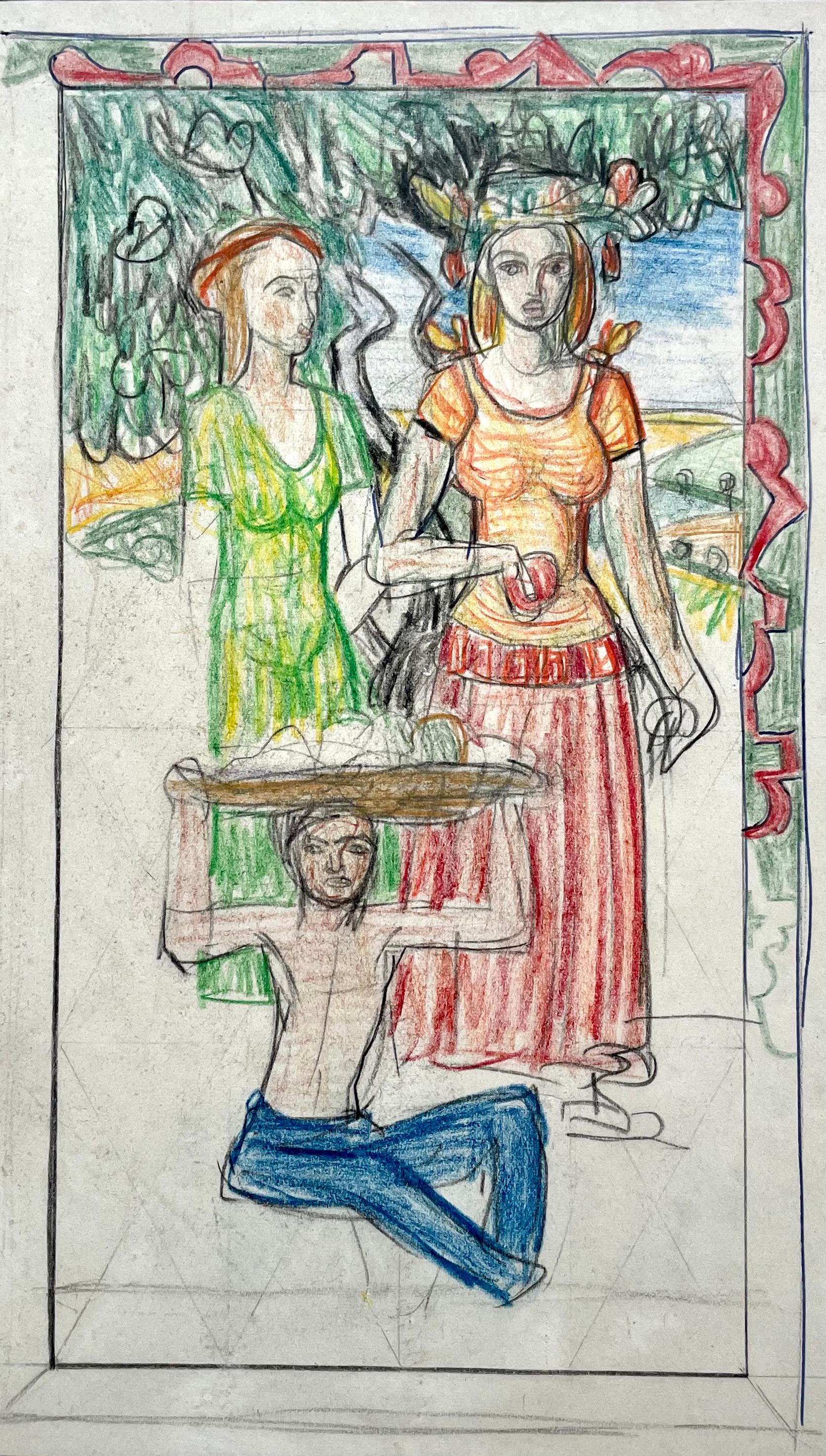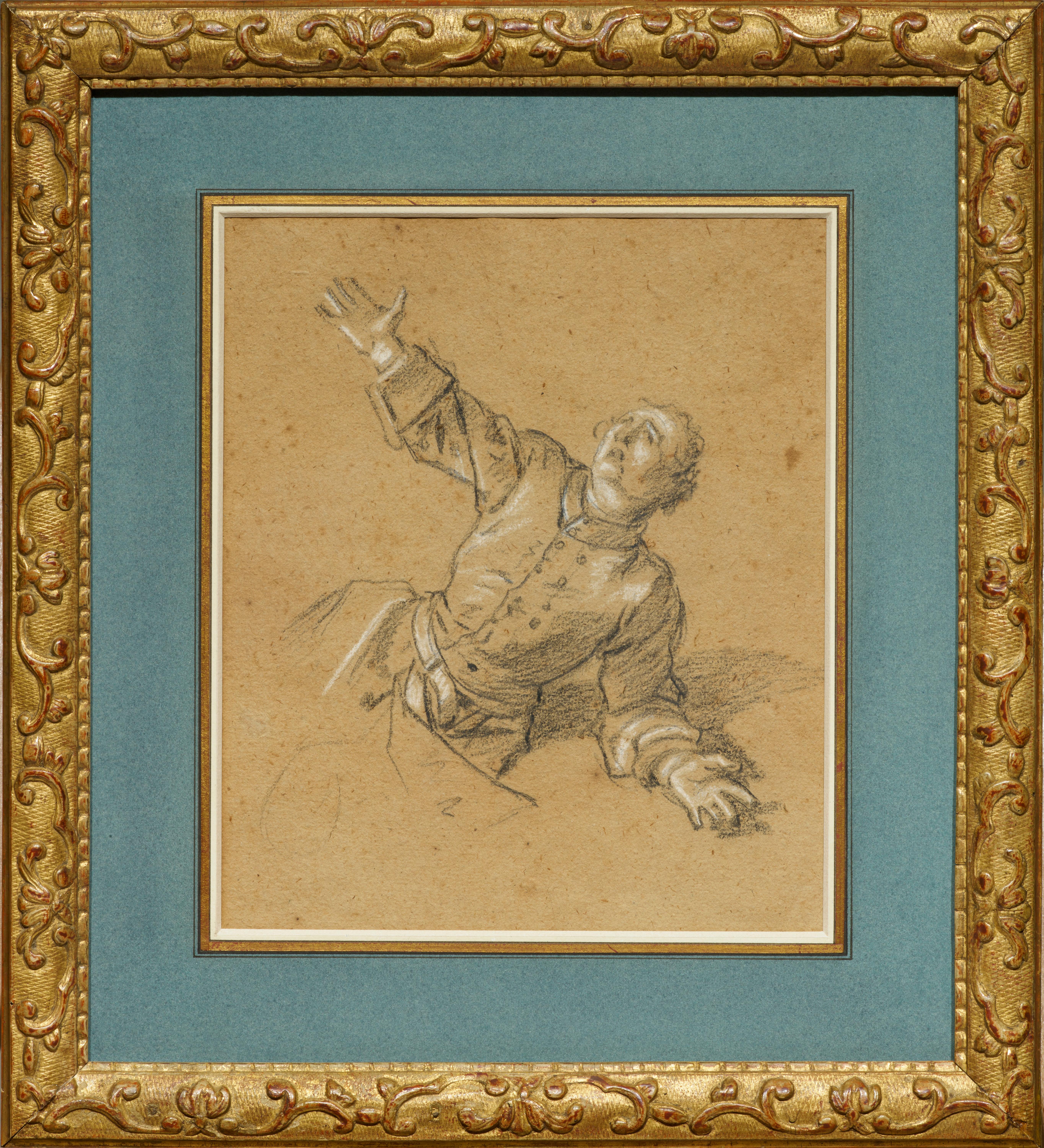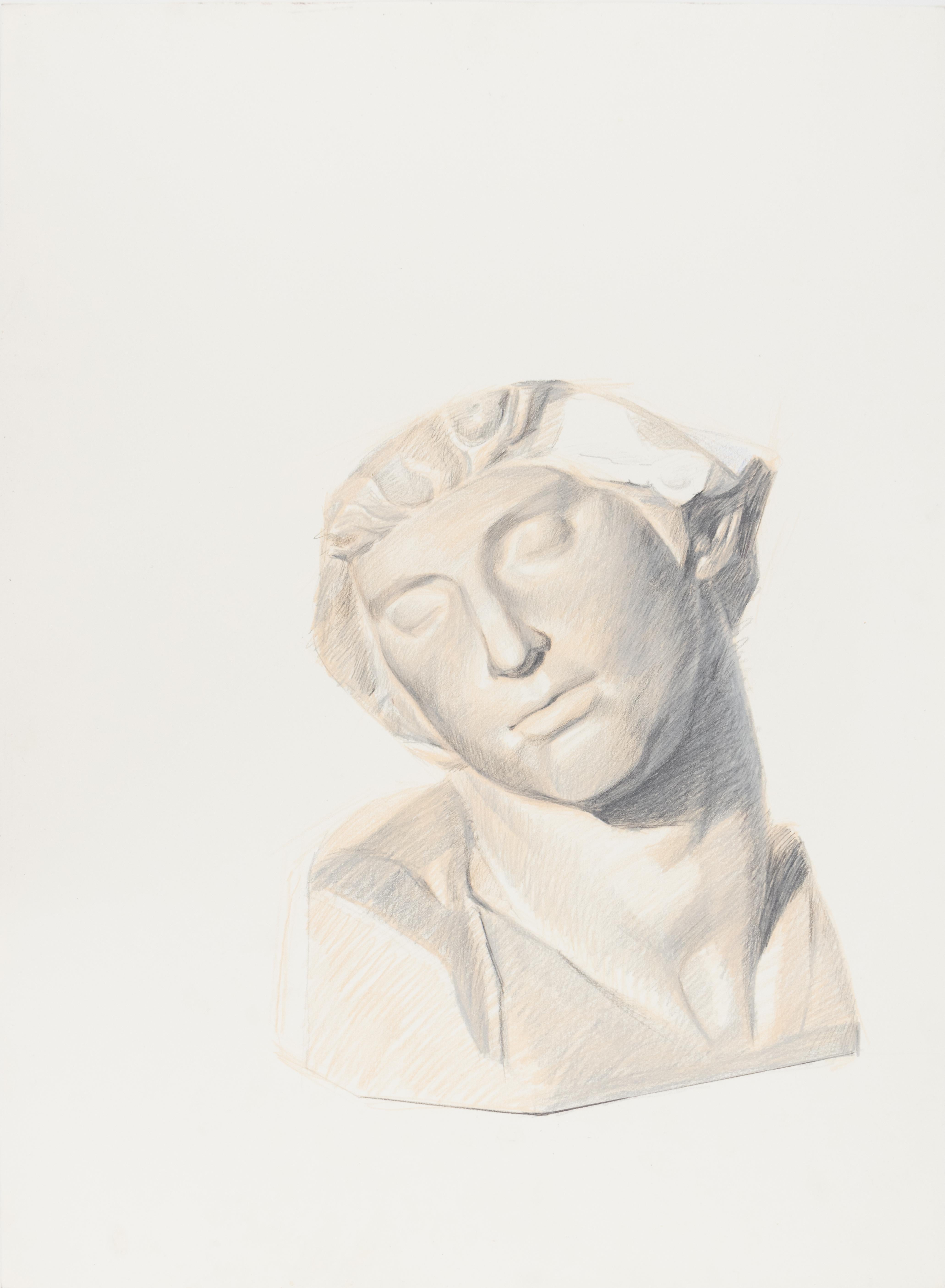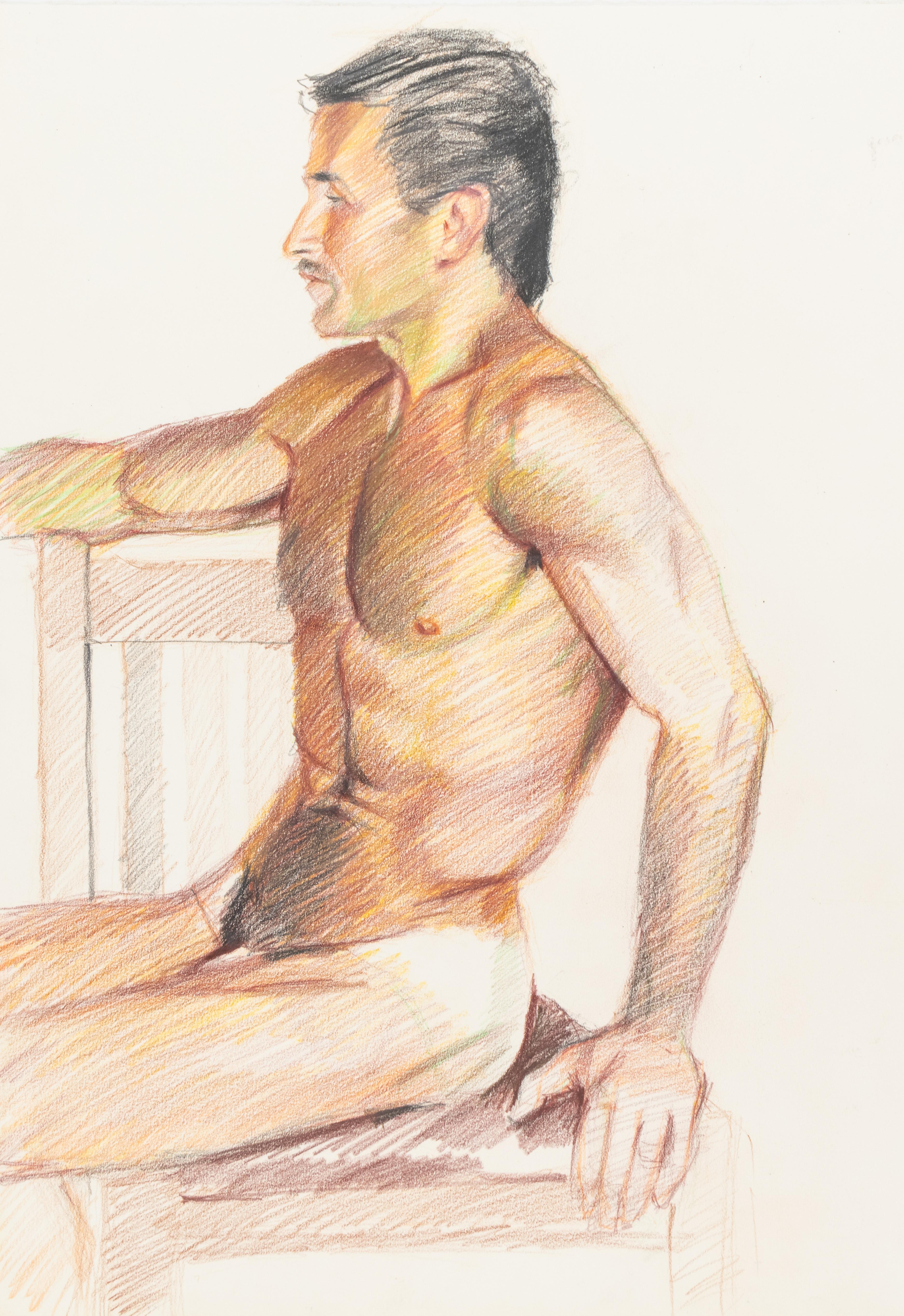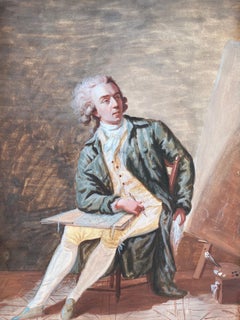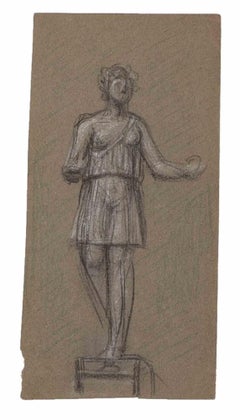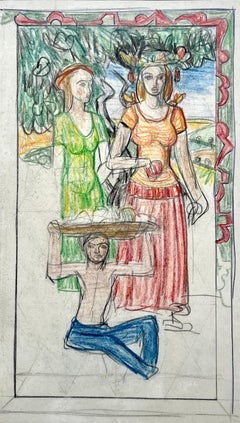A GARLANDED PUTTO HOLDING A CARTOUCHE (After Raphael’s The Prophet Isaiah)
Want more images or videos?
Request additional images or videos from the seller
1 of 7
FLORENTINE SCHOOL c.1550-1600A GARLANDED PUTTO HOLDING A CARTOUCHE (After Raphael’s The Prophet Isaiah)
About the Item
- Creator:FLORENTINE SCHOOL c.1550-1600 (1550 - 1600, Italian)
- Dimensions:Height: 15.28 in (38.8 cm)Width: 9.85 in (25 cm)
- Medium:
- Period:
- Condition:Foxing throughout the sheet, with a repaired tear to the upper left and partial water damage to the upper left corner (partially obscured by frame). The work is in otherwise excellent condition for its age.
- Gallery Location:London, GB
- Reference Number:1stDibs: LU2110212123332
About the Seller
No Reviews Yet
Vetted Seller
These experienced sellers undergo a comprehensive evaluation by our team of in-house experts.
Established in 2020
1stDibs seller since 2022
More From This SellerView All
- ELEMENTS D’ARCHITECTURE, AVEC LE SANGLIER BORGHÈSELocated in London, GBCHARLES PERCIER (1764-1838) ELEMENTS D’ARCHITECTURE, AVEC LE SANGLIER BORGHÈSE Watercolour with pen & ink 29 x 20.8 cm Provenance: With Hazlitt, Gooden & Fox; Where purchased by Si...Category
Late 18th Century Figurative Drawings and Watercolors
MaterialsWatercolor, Pen
- STUDY FOR 'HORATIUS COCLES DEFENDING THE SUBLICIAN BRIDGE' (1620)Located in London, GBSTUDY FOR 'HORATIUS COCLES DEFENDING THE SUBLICIAN BRIDGE' (1620) Pen & ink with sepia wash on laid paper Bears chalk and ink offset swirls verso [from previous backing, conservator's report available upon enquiry] 20.7 x 31.9cm Provenance: [Possibly] Anonymous Sale [from catalogue, "Un Amateur étranger"], Salle de vente, rue Onderbergen, Ghent, Belgium, 01.10.1810 [Lugt Sales Catalogue B-181], Lot 127, Horatius Coclès qui défend le pont ; miniature sur vél. (As Anonymous); [Possibly] From where purchased by Maillieu (for 1 1/2 francs); With the Folio Society Collectors' Corner (as Roman School ( 16th Century)), Stock No. D3740; Private Collection, U.K.; Anonymous Sale, Bamfords Auctioneers & Valuers, Derby, U.K., 24.03.2021, Lot 288 (as Italian Old Master School) We are delighted to present this drawing which we discovered and reattributed last year, following extensive research. It is Hieronymus Francken's study for the oil painting of the same subject, now in the Royal Museum of Fine Arts, Antwerp (Museum Cat. 1948, Inv. No. 163, see second image) painted in 1620 for the Serment des Escrimeurs (Fencers’ Guild) of Antwerp [1]. The present work shows the artist working out the spatial relationships of the figures for the final work, which shows significantly less space beneath the bridge and an altered arrangement to the upper left and right of the work, accounting for areas where the canvas was cut to be framed. Francken's works on paper are vanishingly rare, with only a handful fully attributed to the artist. This drawing therefore represents an important rediscovery in his corpus. Hieronymus Francken II’s autograph signed paintings are also especially scarce: the finished oil of the present subject is one such work. The Antwerp painting...Category
Early 17th Century Flemish School Figurative Drawings and Watercolors
MaterialsInk, Pen
- PORTRAIT OF AN ARTIST AT AN EASEL, HOLDING A PORTFOLIOLocated in London, GBCIRCLE OF JEAN-LAURENT MOSNIER (1743 - 1808) PORTRAIT OF AN ARTIST AT AN EASEL, HOLDING A PORTFOLIO Gouache on card 29 x 20cm The composition of this work is tantalisingly simi...Category
18th Century Figurative Drawings and Watercolors
MaterialsGouache
- FIGURES BY A STREAM IN AN ARCADIAN LANDSCAPELocated in London, GBFIGURES BY A STREAM IN AN ARCADIAN LANDSCAPE Signed & dedicated l.l. a son ami Gallier / Ach. Benouville Pencil, brown washes, chalk & bodycolour on...Category
Mid-19th Century Landscape Drawings and Watercolors
MaterialsChalk, Gouache, Pencil
- PORTRAIT OF A GENTLEMAN IN PROFILEBy George RichmondLocated in London, GBGEORGE RICHMOND, R.A. (1809-1896) PORTRAIT OF A GENTLEMAN IN PROFILE Black, white & red chalks on buff paper 56 x 42 cm Provenance: Private Collection, U.K. As yet, the identity ...Category
19th Century Portrait Drawings and Watercolors
MaterialsChalk
- Gardens of the Villa d'Este by Sunset, TivoliBy Charles-Louis ClérisseauLocated in London, GBCHARLES-LOUIS CLÉRISSEAU (1721-1820) THE GARDENS AT THE VILLA D'ESTE AT SUNSET, TIVOLI Signed l.r. Clérisseau Pen & black ink, pencil, and watercolour, heightened with bodycolour 45.1 x 59 cm 81 x 77 cm [Framed] Provenance: [Purchased by a previous owner in the U.S. for $34,000 according to an earlier label] Private Collection, Madison Avenue, N.Y. ‘I found out Clérisseau .. in whom tho’there is no guile, Yet there is the utmost knowledge of Architecture, of perspective, and of Designing and Colouring I ever Saw, or had any conception of; He rais’d my Ideas, He created emulation and fire in my Breast. I wish’d above all to learn his manner, to have him with me at Rome, to Study close with him and to purchase of his works ..’ (Robert Adam to his brother James, 19th February 1755) Clérisseau was born in Paris and studied there under the auspices of Germaine Boffrand, an architectural draughtsman. At just 25 years old, Clérisseau won the foremost architectural prize in France, the Prix de Rome, and so travelled to the French Academy in Rome (housed in the Villa Medici) to take up residence as a pensionnaire. He arrived in 1749, and began to study under Giovanni Paolo Pannini, the great painter of architectural capricci. Clérisseau befriended two other great architectural draughtsmen, Giovanni Battista Piranesi, and Claude-Joseph Vernet. Clérisseau remained in Rome for eighteen years, becoming an authority on antique Roman architecture, undertaking his own works, including his famous ruin room at the Trinita dei Monti convent, as well as teaching and acting as an artistic cicerone for other visitors. These visitors comprised a series of winners of the Prix de Rome, as well as French and British Grand Tourists, including some of the leading contemporary exponents of British neoclassicism, such as William Chambers and Robert and James Adam. For part of the 1750s, Clérisseau and Robert Adam shared lodgings in the Casa Guarnieri, near to the Spanish Steps. This was arguably one of the most important periods during Adam - who would become one of Britain’s most renowned architects. In his correspondence from this time, Adams mentions how Clérisseau suggested that he first learn to draw a plethora of ornamental motifs, often from Clérisseau’s own designs, before attempting full-scale architectural drawings. Clérisseau and Adam’s drawings from that time are largely rendered in pencil, pen and watercolour, and are either capricci or records of architecture, fragments and ornamental motifs from the buildings they encountered throughout Italy. The latter appear, on the whole, to have been drawn from life. On occasion, Clérisseau’s well-documented distortions of perspective, so as to show a piece of architecture to its best advantage, can be seen in Adam’s work too. The drawings utilise Clérisseau’s characteristic mode of depicting architecture in solid lines of ink but complement this with hazy watercolour backgrounds and imagined topographies. In 1757, Clérisseau even accompanied Robert Adam to Spalatro, Dalmatia (now Split, Croatia) for five weeks in order to survey the ruins of the Palace of the Roman Emperor Diocletian for publication. Following Robert’s departure from Italy, Clérisseau supervised the production of the engravings for his publication, Ruins of the Palace of the Emperor Diocletian at Spalatro… (1764). Moreover, many of the expedition drawings finally selected for engraving are thought to have been by Clérisseau himself rather than Adam or the other accompanying draughtsmen. However, he received no credit for this in Adam’s subsequent book, though this did nothing to stop his reputation’s ascendence. Clérisseau returned to Paris in 1767, a hugely respected artist in his own right. From the French capital, he cultivated a list of eminent clients, which included Catherine the great (who commissioned designs for a house and a triumphal bridge from the artist). The Russian Empress even gave Clérisseau the title Premier Architecte de Sa Majestée Impériale and made him an honorary member of the Imperial Academy of Fine Arts. In 1774, the 1st Marquis of Lansdowne commissioned Clérisseau to make designs for a library for Lansdowne House on Berkeley Square, London, but this was not executed. Soon afterwards, in 1785, Clérisseau was approached by Thomas Jefferson, then the United States Minister to France, to design the Virginia State...Category
Late 18th Century Landscape Drawings and Watercolors
MaterialsWatercolor, Gouache, Pen, Pencil
You May Also Like
- Sketch for a Sculpture - Original Drawing - Early 20th CenturyLocated in Roma, ITSketche for a Sculpture is an original Pencil and Pastel realized by Charles Moulin in early-20th Century. Good condition on a little brown paper. No ...Category
Early 20th Century Modern Figurative Drawings and Watercolors
MaterialsChalk, Pencil
- The Model - 1930s mural design for Eltham Palace by Harry Carleton AttwoodLocated in London, GBHARRY CARLETON ATTWOOD (1907-1985) The Model - Design for Eltham Palace Coloured chalks, arched top Framed 21 by 13 cm., 8 ¼ by 5 in. (frame size 39.5 by 31.5 cm., 15 ½ by 12 ½ in...Category
1930s Art Deco Figurative Drawings and Watercolors
MaterialsChalk
- Fruit Gatherers - 1930s Design for a mural by Harry Carleton AttwoodLocated in London, GBHARRY CARLETON ATTWOOD (1907-1985) Fruit Gatherers - Design for Eltham Palace Chalks Framed 23 by 13 cm., 9 by 5 in. (frame size 39.5 by 31.5 cm., 15 ½ by 12 ½ in.) Attwood was b...Category
1930s Art Deco Figurative Drawings and Watercolors
MaterialsChalk
- Soldier begging for Mercy a preparatory study by Jean-Marc Nattier (1685 - 1766)By Jean-Marc NattierLocated in PARIS, FRThis rare drawing by Nattier is part of a set of preparatory studies executed in 1717 for one of the painter's first commissions, the painting commissioned by Tsar Peter I of Russia ...Category
1710s Old Masters Figurative Drawings and Watercolors
MaterialsChalk
- Untitled (Classical Bust I)By Mark BeardLocated in New York, NYUntitled (Classical Bust I) n.d. Conté crayon on paper 30 x 22 inches Contact gallery for price. This work is offered by CLAMP in New York City.Category
20th Century Contemporary Drawings and Watercolor Paintings
MaterialsPaper, Conté
Price Upon Request - Untitled (Seated Nude Male Facing Left)By Mark BeardLocated in New York, NYConté and colored pencil on paper 20.75 x 14.5 inches Contact gallery for price. This work is offered by CLAMP in New York City.Category
20th Century Contemporary Drawings and Watercolor Paintings
MaterialsPaper, Conté, Color Pencil
Price Upon Request


